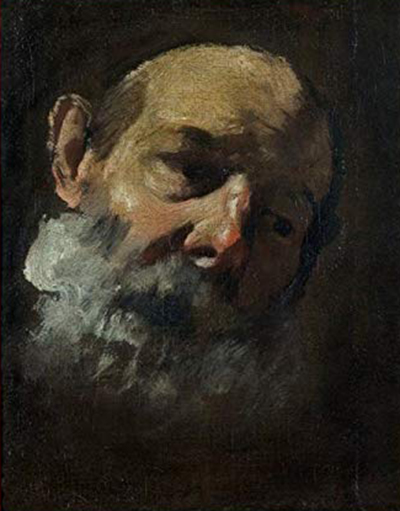Gian Lorenzo Bernini was an esteemed artist of the renaissance era. While Bernini is associated with the verisimilitude of his illusionistic sculptures, he was a man of many talents.
Bernini extended his artistic fervour into painting and portraits, although, paintings only account for a minute portion of Bernini's entire oeuvre. The Head of an Apostle is a lesser-known painting by Bernini, which dates to approximately 1627 – 1629 and was painted using oil on canvas.
Due to the ancillary nature of Bernini's paintings compared to sculptures, not much is known about the Head of an Apostle. No information regarding its' commission exists, however, it is entirely possible that the Head of an Apostle was not specifically commissioned, but rather was created by Bernini due to his devotion and passion for early Christian saints and martyrs. This inference is further supported by the fact that the majority of Bernini's paintings were non-commissioned pieces and were created solely by Bernini to satisfy his artistic proclivity. The painting measures at 42.5 cm long by 33.5 cm wide, and is currently owned by a private collector.
The subject of the painting is simply referred to as "an apostle", with no further information in existence which details precisely who the apostle is. To an objective observer, however, the Head of an Apostle bears a resemblance to Saint Andrew, featured in Bernini's prior painting titled: Saint Andrew and Saint Thomas, which was completed in approximately 1627. The close proximity of creation dates combined with the general resemblance of Saint Andrew and Bernini's devotion to saints produces a compelling inference that the subject is Saint Andrew. As no specific details exist, however, it is impossible to definitely ascertain who the apostle actually is.
The Head of an Apostle features a sole grey-bearded head amongst a pitch black background. Bernini contributed toward significant developments in art, and the Head of an Apostle anticipates impressionism by two centuries. Bernini was one of the first artists with the talent to render a face with minimal, yet confident, brushstrokes. Bernini accurately depicts light as it shines onto one side of the apostle's face and fades into darkness on the other. The expression depicted on the apostle's face is one of melancholy or exhaustion. Considering Bernini's devotion to saints and martyrs, the Head of an Apostle may depict the final moments of Saint Andrew, who was martyred by crucifixion.
The expression of sadness denotes the premature end of the apostle's godly work, and the lighting metaphorically represents the apostle's soul, as it exits his body and fades into death. The grey beard is a sign of wisdom and knowledge, accumulated over a lifetime of devotion to Christianity, all brought to an untimely end. The Head of an Apostle may also metaphorically represent the ignorance of humanity. The grief-stricken expression may be interpreted as a symbol of humanity's irrational delay toward accepting the religion of God. The darkness may represent an abhorrent continuation of the evil and injustice which blackens the soul and proliferates due to the people's refusal to accept the teachings of the wise apostles. The Head of an Apostle is yet another testament to Bernini's skill and artistic talent, which has enshrined Bernini's name in history. Although paintings were not Bernini's primary art form, they are magnificent, nonetheless.




